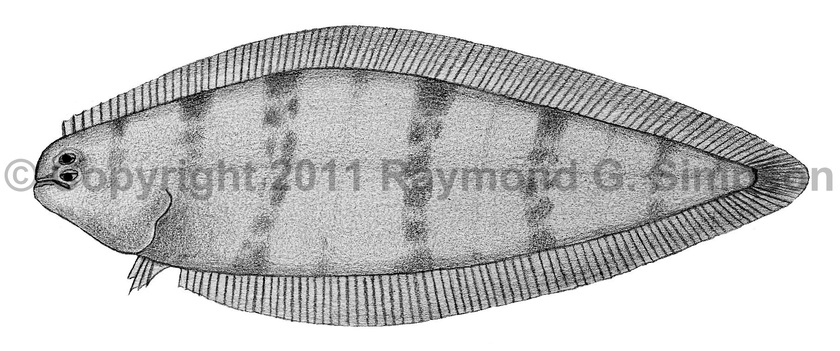
Common Name
Trewava's Tonguefish
Year Described
Chabanaud, 1948
Identification
Dorsal Fin Rays: 88-94
Anal Fin Rays: 73-79
Pectoral Fin Rays: none
Pelvic Fin Rays: 4
Caudal Fin Rays: 10
Longitudinal Scale Rows: 67-77
Vertebrae: 47-51
Pterygiophore pattern (1st three interneural spaces): usually 1-3-3, sometimes 1-4-2 and 1-3-2
Other diagnostic characters include: pupillary operculum absent, no scales on blind side dorsal/anal fin rays, no fleshy ridge on ocular side lower jaw, teeth only present on the anterior half of the premaxilla, teeth on entire margin of dentary, membrane ostia absent, 4 hypurals, 31-37 transverse scale rows, and 15-20 post-orbital scales (Munroe, 1998).
Color
Pale to medium brown with 3-7 distinct dark crossbands on the body posterior to the head. An indistinct band on the head is often present. Opercle lighly pigmented. Peritoneum unpigmented. Fins with light brown pigment (no spots or blotches), darker toward tips of rays. Caudal region without blotch, pigmented like body. Blind side cream.
Size
Specimens range from 50-139mm in length with sexually mature individuals over 70mm.
Habitat
Continental shelf from 7-179m. but more common at moderate depths (40-80m.). An offshore species.
Range Map

Range
Southeastern Brazil to central Argentina
References
Munroe, T.A. 1998. Systematics and ecology of western Atlantic tonguefishes (Symphurus: Cynoglossidae: Pleuronectiformes). Fish. Bull. 96(1):1-182.